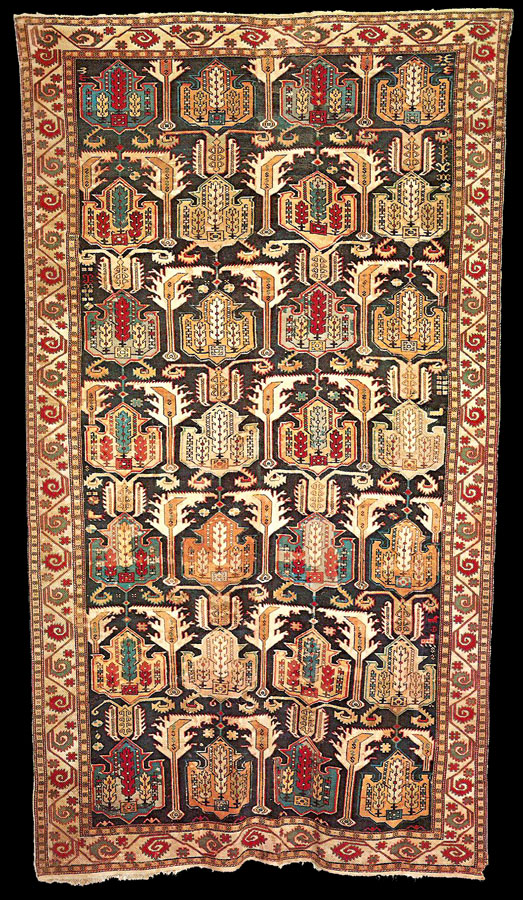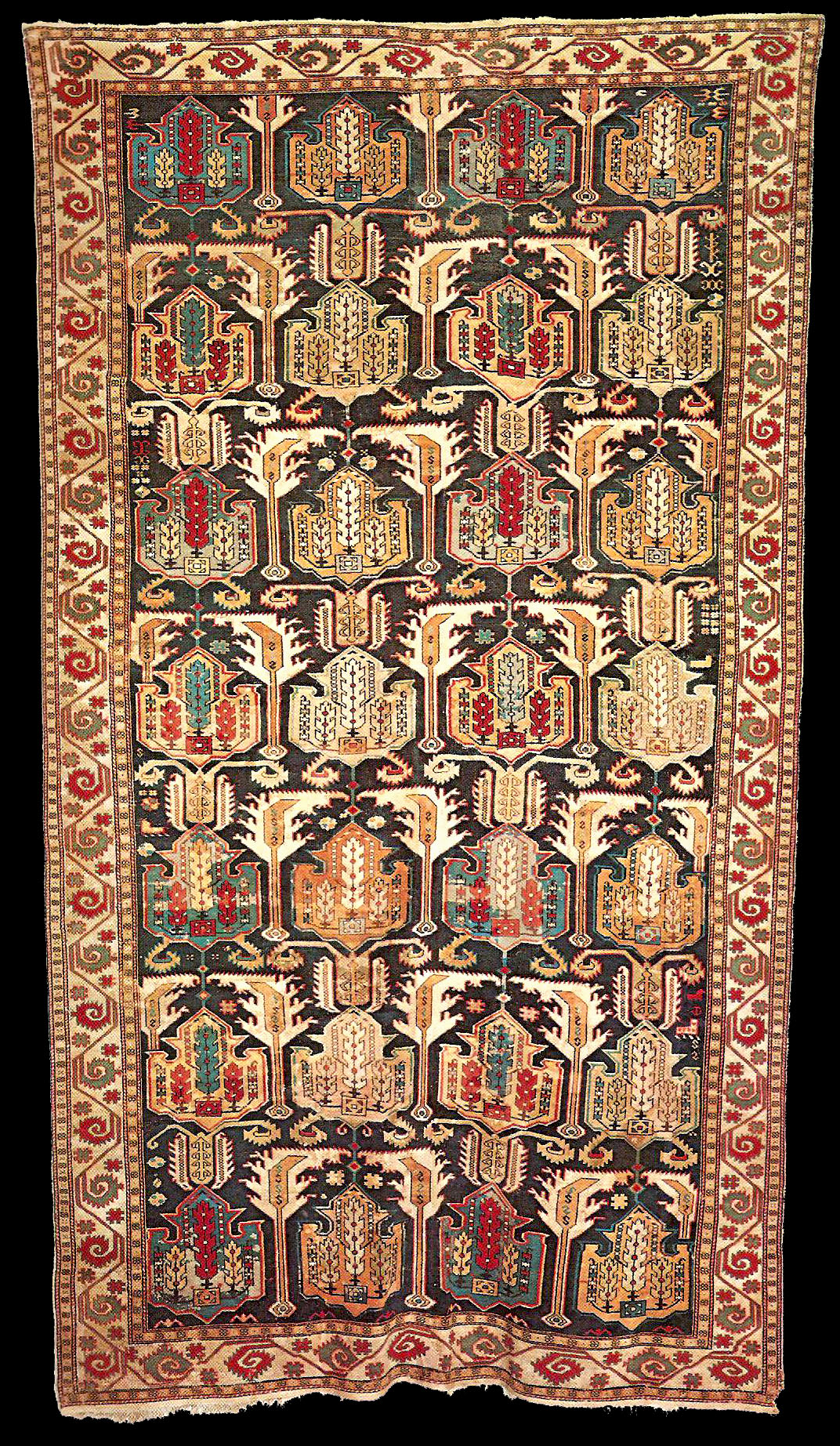|
Rug with Palmettes in a Brocade Pattern. Shirvan, Shemakha Area? 19th
Century. Textile Museum R 36.2.7 (formerly R 2.69).
Upon a ground of dark blue appear seven rows of palmettes, four in a row.
Their coloring alternates from row to row and within each row. In one, the
palmettes are medium blue or abrashed orange shades; in the next, yellow or
beige. Alternate palmettes are "clasped" by a pair of ivory tree-like forms
as if bent by the wind. Beneath the palmettes are pairs of curls, some of
which spring from strange formations that rise from the tips of alternate
palmettes in the row below. Along the edges of the field there are varied
tiny extraneous forms, including four-legged animals in the 19th century
Caucasian manner. The ivory border displays a blue-green sweeping vine that
breaks out into curls outlined in red, or in red outlined with blue-green.
In the open spaces are ticktacktoe figures in the same coloring. The guard
stripes are a dull orange.
Most of the dozen known rugs and fragments in this pattern conform closely
to this precisely repetitive model, in which nothing seems clearly
indicative of an earlier production date than the 19th century. Louisa
Bellinger, former Curator of the Textile Museum, used to speak of this rug
as a "Gay Nineties" carpet, and her intuition may well have been correct.
Silk is ordinarily incorporated in the foundations of these rugs, in the
warps, wefts or in both. Far from the early datings that have been accorded
them in the past, they seem to represent an unusually fine production level
of Shirvan carpets, extending in other patterns on into the 20th century. In
this respect it may be significant that no examples were found among the
storage rugs of the Museum of Turkish and Islamic Art in Istanbul, which
represent the antique rugs that were culled from many mosques.
Typical rugs in this pattern are owned by the Metropolitan Museum of Art,
22.100.118 (Dimand 8: Mailey 1973: Fig. 230); the Benaki Museum in Athens,
No. 510 (Rice 1965: Fig. 249); Old Deerfield, Mass. No. 94; by Vojtech Blau
in New York. One, formerly in a Hungarian collection, and then in that of
Badih Bulos in Beirut, was sold at Sotheby's in 1969. Another, formerly in
the Hollitscher Collection in Berlin (Frdmann 1960: Fig. 116) is said to be
at Caramoor in Westchester County, N.Y. All apparently have blue grounds.
The key to comprehension of the pattern as it is expressed in this series of
rugs appears to
lie in a carpet, now shortened, in the Musee des Arts Decoratifs in Paris,
No. 7823. which may date from the late 18th century- (Erd mann 1960: Fig.
115). Here the tiny forms within the palmette are still recognizable as
three cypress trees and there are two ducks within the rectangle below the
central cypress. The clasping tree-like forms are seen to be serrated lancet
leaves which spring from vines that meander the length of the field between
the rows of palmettes. The palmettes themselves appear in alternation with
an octagram-shaped star blossom which has been borrowed from 16th/ 17th
century Turkish velvets. The palmette as well has likely been drawn from a
similar source, as has remarked by others. One particular palmette and the
border pattern have been based Herat or Agra models, whereas in the Textile
Museum rug, Plate 33, as in the Metropolitan, Deerfield and Athens examples,
the border displays a design which is found, in the same draftsmanship, in
one series of 19th century Yomud Turkoman pentagonal mats, or "osmolduks". (Schurmann
1969: Pl. 34: Moskova 1970: Fig. 61). This pattern seems to have jumped the
Caspian. Following W.B. Denny's suggestion that the origin of the pattern
might lie in tilework, it is instructive to compare the design of the carpet
in Paris (Erdmann 1960: Fig. 115) with that of a 16th century Ottoman
Turkish tile at Fenway Court in Boston in Dr. Denny's reconstruction (1971;
Fig. 6). The resemblance is striking despite the degeneration of elements.
Size: L. 3.13 m. (10'3") x W. 1.80 m. (5'11").
Warp: Z4S, three strands being ivory cotton and strand ivory silk which may
show traces of pink dye, In some warps two strands are silk; in others
allare
cotton. One level.
Weft: Z'2S winder plied silk, dyed light red. Two shots
Pile: 2Z wool. Gordes knotted, pile slanting slightly to right. 9 horiz. x
13 or 14 vert. per in. (about 120 per sq.in.).
Sides: Probably not original. A four cord selvage of Z4S ivory silk (or
Mercerized cotton), selvage-attached at 1/4 intervals.
Ends: Cut. Modern kilims of similar material to selvedge
Colors: Ivory; black-brown; dull orange, abrashed pale orange; beige;
yellow; red; dark and medium blues, blue-green; pale gray-green. Several
colors may have
faded badly.
Condition: Moderate amount of reknotting. Published: Pope 1926: No. 36;
Ellis 1970: Fig. 14.
|
 |


